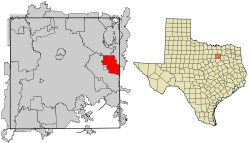Sunnyvale, Texas
USGenWeb >>
TXGenWeb >>
Dallas County
>> Towns & Communities >>
Sunnyvale, Texas
| Historical
population |
| Census |
Pop. |
%± |
| 1960 |
969 |
— |
| 1970 |
995 |
2.7% |
| 1980 |
1,404 |
41.1% |
| 1990 |
2,228 |
58.7% |
| 2000 |
2,693 |
20.9% |
| 2010 |
5,130 |
90.5% |
|
The town now called Sunnyvale was inhabited by various Native
American tribes in the years before the European conquest of the
Americas. It became under the rule of Spain in the 18th century,
very close to the boundary of Spanish and French territory (although
this boundary was carried upward a bit in 1819; see Adams-Onís
Treaty.) During this time, the area was relatively underdeveloped.
However, some settlers migrated to Texas and would eventually settle
in Sunnyvale. In 1821, the town became a possession of Mexico when
Mexico received its independence from Spain. After the Texas
Revolution, the area once again changed hands, under the Republic of
Texas. This is when the town started to develop. During this time,
settlers migrated to present-day Sunnyvale, naming the hamlet they
founded Long Creek. In 1845 Texas became a United States state. More
settlers migrated to the area. In the 1860s, the town was briefly
part of the Confederate States of America. As more people arrived,
eventually three new towns sprang up in the area: New Hope, Tripp,
and Hatterville. New Hope was the most prosperous of these. It had
many shops and stores, a fair called Gala Days, and a newspaper, the
New Hope News. It was neighboring Mesquite's biggest rival. This all
ended in 1921, when a storm blew the town away. Many buildings were
damaged and the prosperous days were over. From this year on to the
1950s, the four towns had no new developments, remaining stagnant.
In the year 1953, the hamlets of Hatterville, New Hope, Long Creek,
and Tripp merged under the name Sunnyvale. The name was chosen in a
contest from a local school. Today, there are many reminders of
Sunnyvale's rich history, like the old New Hope School; the Tripp
First Baptist Church, built in 1882; and many antique houses. The
Long Creek Cemetery in southern Sunnyvale is over 150 years old, and
the first recorded burial there is that of Leona Crownover Caldwell,
dated October 2, 1855. There are also veterans from most major
American wars, including the War of 1812, the Civil War (both Union
and Confederate veterans), the World Wars, and others. Some of the
oldest burials in the cemetery include James Truss and Priscilla
Dulaney Truss, both born in 1799. In March 2012, Sunnyvale, Texas
was named the whitest town in North Texas by D Magazine, and the
power of that article was something that is still brought up today.
The reason that Sunnyvale was named the whitest town in North Texas
was based on an initial, U.S. District Judge Jerry Buchmeyern study
that deducted that out of 2,228 residents in Sunnyvale, TX, that
only 16 of them were African American. On December 26, 2015 the town
was struck by an EF-4 tornado causing extensive damage to the
Plantation RV park, the tornado then grew and moved northeast into
Garland and Rowlett killing 12 people and injuring dozens.
....
Read More Wikipedia ....
Matthew Hayes Nall
Sunnyvale is on U.S. Highway 80 between Mesquite and Garland twelve
miles east of Dallas in far eastern Dallas County. The site is on
about forty-five original land grants, the largest four being those
of J. Johnson, P. Green, M. A. Freeman, and T. D. Coats. Sunnyvale
was incorporated on February 26, 1953. The town incorporated the
communities of New Hope, Tripp, Hattersville, and Long Creek. New
Hope and Tripp each had several stores, a church, and a school at
the time. The area of old New Hope along Beltline Road became Main
Street in Sunnyvale, and in 1965 the old New Hope school served as
the Sunnyvale town hall. By 1982 the building served as the city
library. Around the time of incorporation Sunnyvale was named by the
students of the Tripp-Long Creek school in a contest initiated by
area officials. The students originally chose Sunnyville, but that
name was already claimed by another community. Sunnyvale had a
population of 1,000 and an industrial-equipment factory in 1958. By
1982 the population began to grow, and by 1991 the community had
five construction-related industries and one drilling-equipment
manufacturer. The population in 1990 was 2,228. On October 4, 1994,
a 105-year-old landmark store, Lander's Mercantile-E. E. Kearney,
Dealers in Everything, burned. In 2000 the population was 2,693.
BIBLIOGRAPHY: Dallas Morning News, October 5, 1994. Dallas Times
Herald, July 20, 1958, October 30, 1960. Daniel Hardy, Dallas County
Historic Resource Survey (Dallas: Dallas County Historical
Commission, 1982). Dennis Holder, "Don't Mess With Sunnyvale," D
Magazine, September 1988. Vertical Files, Dolph Briscoe Center for
American History, University of Texas at Austin.
Handbook of Texas Online, Matthew Hayes Nall, "SUNNYVALE,
TX"





